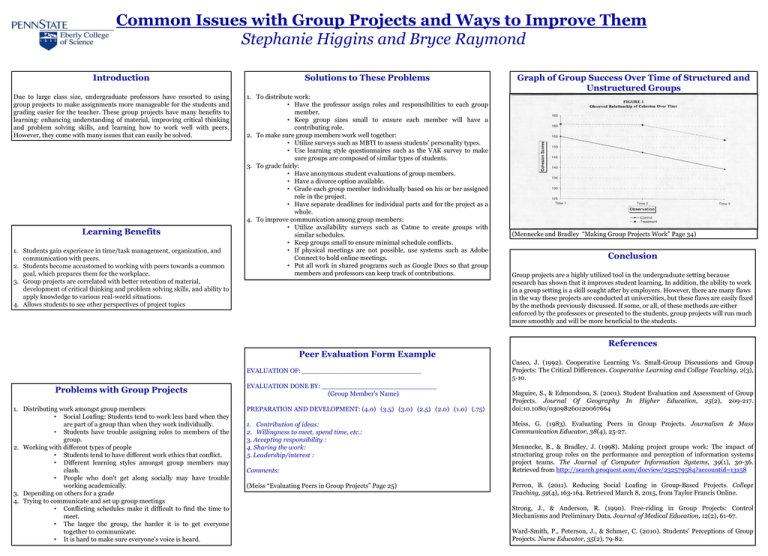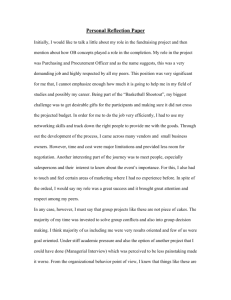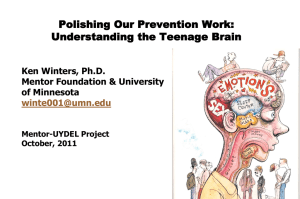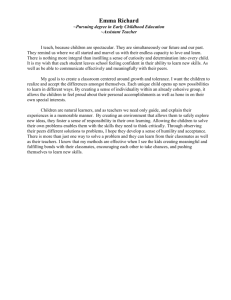Common Issues with Group Projects and Ways to Improve Them
advertisement

Common Issues with Group Projects and Ways to Improve Them Stephanie Higgins and Bryce Raymond Introduction Solutions to These Problems Due to large class size, undergraduate professors have resorted to using group projects to make assignments more manageable for the students and grading easier for the teacher. These group projects have many benefits to learning: enhancing understanding of material, improving critical thinking and problem solving skills, and learning how to work well with peers. However, they come with many issues that can easily be solved. 1. To distribute work: • Have the professor assign roles and responsibilities to each group member. • Keep group sizes small to ensure each member will have a contributing role. 2. To make sure group members work well together: • Utilize surveys such as MBTI to assess students’ personality types. • Use learning style questionnaires such as the VAK survey to make sure groups are composed of similar types of students. 3. To grade fairly: • Have anonymous student evaluations of group members. • Have a divorce option available. • Grade each group member individually based on his or her assigned role in the project. • Have separate deadlines for individual parts and for the project as a whole. 4. To improve communication among group members: • Utilize availability surveys such as Catme to create groups with similar schedules. • Keep groups small to ensure minimal schedule conflicts. • If physical meetings are not possible, use systems such as Adobe Connect to hold online meetings. • Put all work in shared programs such as Google Docs so that group members and professors can keep track of contributions. Learning Benefits 1. Students gain experience in time/task management, organization, and communication with peers. 2. Students become accustomed to working with peers towards a common goal, which prepares them for the workplace. 3. Group projects are correlated with better retention of material, development of critical thinking and problem solving skills, and ability to apply knowledge to various real-world situations. 4. Allows students to see other perspectives of project topics Graph of Group Success Over Time of Structured and Unstructured Groups (Mennecke and Bradley “Making Group Projects Work” Page 34) Conclusion Group projects are a highly utilized tool in the undergraduate setting because research has shown that it improves student learning. In addition, the ability to work in a group setting is a skill sought after by employers. However, there are many flaws in the way these projects are conducted at universities, but these flaws are easily fixed by the methods previously discussed. If some, or all, of these methods are either enforced by the professors or presented to the students, group projects will run much more smoothly and will be more beneficial to the students. References Peer Evaluation Form Example EVALUATION OF: _____________________________ Problems with Group Projects 1. Distributing work amongst group members • Social Loafing: Students tend to work less hard when they are part of a group than when they work individually. • Students have trouble assigning roles to members of the group. 2. Working with different types of people • Students tend to have different work ethics that conflict. • Different learning styles amongst group members may clash. • People who don’t get along socially may have trouble working academically. 3. Depending on others for a grade 4. Trying to communicate and set up group meetings • Conflicting schedules make it difficult to find the time to meet. • The larger the group, the harder it is to get everyone together to communicate. • It is hard to make sure everyone’s voice is heard. EVALUATION DONE BY: ____________________________ (Group Member’s Name) PREPARATION AND DEVELOPMENT: (4.0) (3.5) (3.0) (2.5) (2.0) (1.0) (.75) 1. Contribution of ideas: 2. Willingness to meet, spend time, etc.: 3. Accepting responsibility : 4. Sharing the work: 5. Leadership/interest : Comments: (Meiss “Evaluating Peers in Group Projects” Page 25) Cuseo, J. (1992). Cooperative Learning Vs. Small-Group Discussions and Group Projects: The Critical Differences. Cooperative Learning and College Teaching, 2(3), 5-10. Maguire, S., & Edmondson, S. (2001). Student Evaluation and Assessment of Group Projects. Journal Of Geography In Higher Education, 25(2), 209-217. doi:10.1080/03098260120067664 Meiss, G. (1983). Evaluating Peers in Group Projects. Journalism & Mass Communication Educator, 38(4), 25-27. Mennecke, B., & Bradley, J. (1998). Making project groups work: The impact of structuring group roles on the performance and perception of information systems project teams. The Journal of Computer Information Systems, 39(1), 30-36. Retrieved from http://search.proquest.com/docview/232579584?accountid=13158 Perron, B. (2011). Reducing Social Loafing in Group-Based Projects. College Teaching, 59(4), 163-164. Retrieved March 8, 2015, from Taylor Francis Online. Strong, J., & Anderson, R. (1990). Free-riding in Group Projects: Control Mechanisms and Preliminary Data. Journal of Medical Education, 12(2), 61-67. Ward-Smith, P., Peterson, J., & Schmer, C. (2010). Students' Perceptions of Group Projects. Nurse Educator, 35(2), 79-82.






